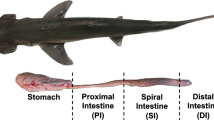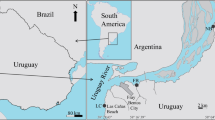Abstract
We explored possible diet-related specializations in the digestive tract of stomachless fishes by summarizing the diets, verifying the absence of a stomach, and comparing gut lengths, microvilli surface areas, and activities of five digestive enzymes in four taxa of silversides from southern California coastal waters. For the comparisons, we examined these gut features in Atherinops affinis from both estuarine and kelp-forest habitats, and Atherinopsis californiensis and Leuresthes tenuis from open coastal habitats. A. affinis was found to be primarily herbivorous in estuaries and carnivorous in kelp forests, whereas As. californiensis was shown to be somewhat omnivorous but mainly carnivorous, and L. tenuis strictly carnivorous. Estuarine A. affinis exhibited the longest gut, largest microvilli surface area, and highest amylase and maltase activities, all arguably reflecting responses to an algal diet. In contrast, kelp-forest A. affinis displayed the highest trypsin activity and generally similar microvilli surface areas and aminopeptidase, amylase, and maltase activities to the two other carnivorous taxa. All four taxa showed similar lipase activities that compared closely with published values for other fishes. Taken together, our results reveal striking differences in gut structure and function among the four taxa, but especially between the estuarine and kelp-forest populations of A. affinis. Further studies are required to assess the roles of genetic variation and phenotypic plasticity in explaining the differences in these herbivorous and carnivorous taxa.





Similar content being viewed by others
References
Allen LG, Findlay AM, Phalen CM (2002) Structure and standing stock of the fish assemblages of San Diego Bay, California from 1994 to 1999. Bull So Calif Acad Sci 101:49–85
Barry JM, Yoklavich MM, Cailliet GM, Ambrose DM, Antrim BS (1996) Trophic ecology of the dominant fishes in Elkhorn Slough, California, 1974–1980. Estuaries 19:115–138
Buddington RK, Krogdahl A, Bakke-McKellep AM (1997) The intestines of carnivorous fish: structure and functions and the relations to diet. Acta Physiol Scand 161:67–80
Chan AS, Horn MH, Dickson KA, Gawlicka A (2004) Digestive enzyme activities in carnivores and herbivores: comparisons among four closely related prickleback fishes (Teleostei: Stichaeidae) from a California rocky intertidal habitat. J Fish Biol 65:848–858
Clarke KR (1993) Non-parametric multivariate analysis of changes in community structure. Aust J Ecol 18:117–143
Clements KD, Bellwood DR (1988) A comparison of the feeding mechanisms of two herbivorous labroid fishes, the temperate Odax pullus and the tropical Scarus rubroviolaceus. Aust J Mar Freshw Res 39:87–107
Clements KD, Choat JH (1995) Fermentation in tropical marine herbivorous fishes. Physiol Zool 68:355–378
Crabtree CB (1986) Systematics and taxonomy of the members of the Atherinopsinae (Pisces: Atherinidae). PhD dissertation, University of California
Crabtree CB (1987) Allozyme evidence for the phylogenetic relationships within the silverside subfamily Atherinopsinae. Copeia 1987:860–867
Crabtree CB (1989) A new silverside of the genus Colpichthys (Atheriniformes: Atherinidae) from the Gulf of California, Mexico. Copeia 1989:558–568
Drewe KE, Horn MH, Dickson KA, Gawlicka A (2004) Insectivore to frugivore: ontogenetic changes in gut morphology and digestive enzyme activity in the characid fish Brycon guatemalensis from Costa Rican rain forest streams. J Fish Biol 64:890–902
Dyer BS (1997) Phylogenetic revision of Atherinopsinae (Teleostei, Atherinopsidae), with comments on the systematics of the South American freshwater fish genus Basilichthys Girard. Misc Pub Mus Zool Univ Michigan No. 185
Eschmeyer WN, Herald ES, Hammann H (1983) A field guide to Pacific coast fishes of North America. Houghton Mifflin Company, Boston
Fernandez I, Moyano FJ, Diaz M, Martinez T (2001) Characterization of α-amylase in five species of Mediterranean sparid fishes (Sparidae, Teleostei). J Exp Mar Biol Ecol 262:1–12
Frierson EW, Foltz JW (1992) Comparison and estimation of absorptive intestinal surface area in two species of cichlid fish. Trans Am Fish Soc 121:517–523
German DP, Horn MH (2006) Gut length and mass in herbivorous and carnivorous prickleback fishes (Teleostei: Stichaeidae): ontogenetic, dietary, and phylogenetic effects. Mar Biol (in press)
German DP, Horn MH, Gawlicka A (2004) Digestive enzyme activities in herbivorous and carnivorous prickleback fishes (Teleostei: Stichaeidae): ontogenetic, dietary, and phylogenetic effects. Physiol Biochem Zool 77:789–804
Hidalgo MC, Urea E, Sanz A (1999) Comparative study of digestive enzymes in fish with different nutritional habits. Proteolytic and amylase activities. Aquaculture 170:267–283
Horn MH (1989) Biology of marine herbivorous fishes. Oceanogr Mar Biol Annu Rev 27:167–272
Horn MH, Allen LG (1985) Fish community ecology in southern California bays and estuaries. In: Yañez-Arancibia A (ed) Fish community ecology in estuaries and coastal lagoons: towards an ecosystem integration. UNAM Press, Mexico, pp 169–190
Horn MH, Messer KS (1992) Fish guts as chemical reactors: a model of the alimentary canals of marine herbivorous fishes. Mar Biol 113:527–535
Horn MH, Ojeda FP (1999) Herbivory. In: Horn MH, Martin KLM, Chotkowski MA (eds) Intertidal fishes: life in two worlds. Academic, San Diego, pp 197–222
Hubbs CL (1918) The fishes of the genus Atherinops, their variation, distribution, relationships, and history. Bull Am Mus Nat Hist 38:409–440
Jones RS (1968) A suggested method for quantifying gut contents in herbivorous fishes. Micronesica 4:369–371
Klingbeil RA (1972) A comparative study of the food and feeding of the teleostean fishes in Anaheim Bay, California. MA Thesis, California State University
Koelz HR (1992) Gastric acid in vertebrates. Scand J Gastroenterol 27 (Suppl 193):2–6
Logothetis EA, Horn MH, Dickson KA (2001) Gut morphology and function in Atherinops affinis (Teleostei: Atherinopsidae), a stomachless omnivore feeding on macroalgae. J Fish Biol 59:1298–1312
Miller DJ, Lea RN (1972) Guide to the coastal marine fishes of California. Calif Fish Game Fish Bull No. 157
Moran D, Clements KD (2002) Diet and endogenous carbohydrases in the temperate marine herbivorous fish Kyphosus sydneyanus (Perciformes: Kyphosidae). J Fish Biol 60:1190–1203
Mountfort DO, Campbell J, Clements KD (2002) Hindgut fermentation in three species of marine herbivorous fish. Appl Environ Microbiol 68:1374–1380
O’Reilly KM, Horn MH (2004) Phenotypic variation among populations of Atherinops affinis (Atherinopsidae) with insights from a geometric morphometric analysis. J Fish Biol 64:1117–1135
Quast JC (1968) Observations on the food of the kelp-bed fishes. In: North WJ, Hubbs CL (eds) Utilization of kelp-bed resources in southern California. Calif Dept Fish Game Fish Bull, 139, pp 109–142
Rimmer DW, Wiebe WJ (1987) Fermentative microbial digestion in herbivorous fishes. J Fish Biol 31:229–236
Sabapathy U, Teo LH (1993) A quantitative study of some digestive enzymes in the rabbitfish, Siganus canaliculatus and the sea bass, Lates calcarifer. J Fish Biol 42:595–602
Smith DR (2002) Trophic position of estuarine and kelp-bed populations of the omnivorous silverside fish Atherinops affinis (Teleostei: Atherinopsidae) from southern California: analyses of dietary items and 15N and 13C stable isotopes. MS Thesis, California State University
Tibbetts IR (1991) The trophic ecology, functional morphology and phylogeny of the Hemiramphidae (Beloniformes). PhD Thesis, University of Queensland
Tibbetts IR (1997) The distribution and function of mucous cells and their secretions in the alimentary tract of Arrhamphus sclerolepis krefftii. J Fish Biol 50:809–820
Valle CF, O’Brien JW, Weise KB (1999) Differential habitat use by California halibut, Paralichthys californicus, barred sand bass, Paralabrax nebulifer, and other juvenile fishes in Alamitos Bay, California. Fish Bull 97:646–660
White BN (1985) Evolutionary relationships of the Atherinopsinae (Pisces: Atherinidae). Nat Hist Mus Los Angeles Co Contrib Sci No 368
Acknowledgements
We thank D. Smith, K. O’Reilly, W. Dahdul, M. Saba, A. Chan, K. Drewe, E. Cox, and C. Sepulveda for assistance in the field, K. Kim, C. Freeman, and J. Marasigan for help in the laboratory, and S. Karl for aid with electron microscopy. Financial support was provided by a grant (OCE-9906857) from the National Science Foundation (M.H. Horn, principal investigator) and by a grant to California State University, Fullerton, from the Minority Scientist Development Program of the National Institutes of Health. All handling of fish from capture to euthanization was conducted under approved protocols 98-R-01 and 02-R-02 of the Institutional Animal Care and Use Committee at California State University, Fullerton.
Author information
Authors and Affiliations
Corresponding author
Additional information
Communicated by P.W. Sammarco, Chauvin
Rights and permissions
About this article
Cite this article
Horn, M.H., Gawlicka, A.K., German, D.P. et al. Structure and function of the stomachless digestive system in three related species of New World silverside fishes (Atherinopsidae) representing herbivory, omnivory, and carnivory. Mar Biol 149, 1237–1245 (2006). https://doi.org/10.1007/s00227-006-0281-9
Received:
Accepted:
Published:
Issue Date:
DOI: https://doi.org/10.1007/s00227-006-0281-9




